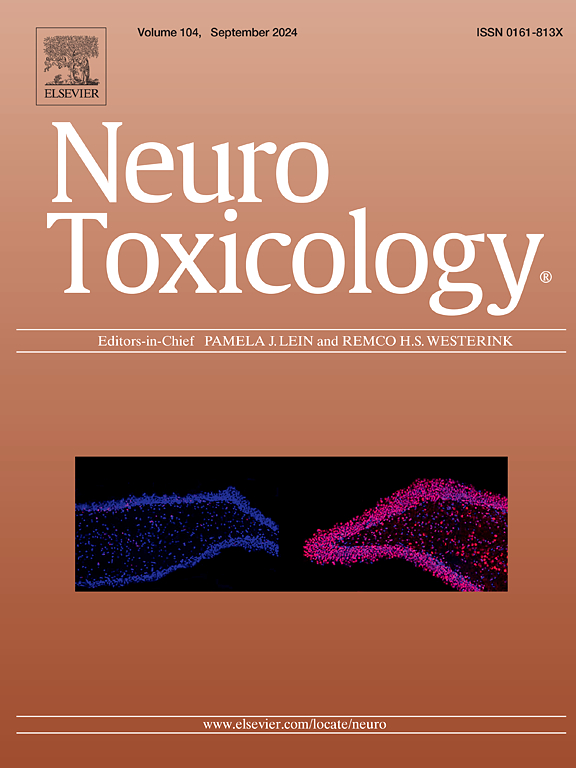与神经退行性疾病相关的氯化溶剂诱导神经毒性并损害自噬通量。
IF 3.9
3区 医学
Q2 NEUROSCIENCES
引用次数: 0
摘要
遗传对神经退行性疾病的贡献为研究环境暴露与神经退行性疾病之间的相互作用开辟了途径。流行病学研究已经确定了一些氯化溶剂作为神经退行性疾病风险的潜在调节剂,但对其神经毒性的分子机制知之甚少。为此,我们研究了暴露于氯化溶剂如何诱导野生型和转基因斑马鱼的神经毒性。通过一系列测量运动、神经元数量和自噬通量变化的实验来筛选氯化溶剂的神经毒性。暴露于所有氯化溶剂的斑马鱼幼虫运动能力下降,除1,2-二氯乙烷(EDC)和1,2-二氯丙烷(PDC)外的所有溶剂都导致单胺能神经元丧失。导致神经元损失的溶剂,包括四氯化碳(carbon Tet)、二氯甲烷(DCM)、四氯乙烯(PCE)和三氯乙烯(TCE),也会导致自噬通量受损,自噬体形成率下降,p62点增加。综上所述,氯化甲烷和乙烯引起的神经毒性表现为行为改变、神经元丧失和中枢神经系统自噬通量降低,而氯化乙烷和丙烷则没有。这项研究进一步证实了溶剂暴露与神经退行性疾病之间的流行病学联系,并强调了理解可能累积导致疾病风险的机制联系的重要性。本文章由计算机程序翻译,如有差异,请以英文原文为准。
Chlorinated solvents associated with neurodegenerative disease induce neurotoxicity and impair autophagic flux
Contributions of genetic heredity to neurodegenerative diseases have opened avenues of investigations into the interplay between environmental exposures and neurodegeneration. Epidemiological studies have identified some chlorinated solvents as potential modifiers of neurodegenerative disease risk, but not much is known about the molecular mechanisms underlying their neurotoxic potencies. To this end, we investigated how exposure to chlorinated solvents might induce neurotoxicity in wild-type and transgenic zebrafish. Chlorinated solvents were screened for neurotoxicity through a series of assays measuring changes in locomotion, neuron numbers, and autophagic flux. Decreased locomotion was observed in zebrafish larvae exposed to all chlorinated solvents and all but 1,2-dichloroethane (EDC) and 1,2-dichloropropane (PDC) led to monoaminergic neuron loss. Solvents that induced neuron loss, including carbon tetrachloride (Carbon Tet), dichloromethane (DCM), tetrachloroethylene (PCE), and trichloroethylene (TCE), also caused impairments in autophagic flux, as evidenced by decreased rates of autophagosome formation and increased p62 punctae. In summary, chlorinated methanes and ethenes induced neurotoxicity as evident by behavioral changes, neuronal loss, and reduced autophagic flux in the central nervous system, whereas chlorinated ethanes and propanes did not. This study lends further credence to the epidemiological associations connecting solvent exposure to neurodegenerative disease and highlights the importance of understanding mechanistic links that may cumulatively contribute to disease risk.
求助全文
通过发布文献求助,成功后即可免费获取论文全文。
去求助
来源期刊

Neurotoxicology
医学-毒理学
CiteScore
6.80
自引率
5.90%
发文量
161
审稿时长
70 days
期刊介绍:
NeuroToxicology specializes in publishing the best peer-reviewed original research papers dealing with the effects of toxic substances on the nervous system of humans and experimental animals of all ages. The Journal emphasizes papers dealing with the neurotoxic effects of environmentally significant chemical hazards, manufactured drugs and naturally occurring compounds.
 求助内容:
求助内容: 应助结果提醒方式:
应助结果提醒方式:


